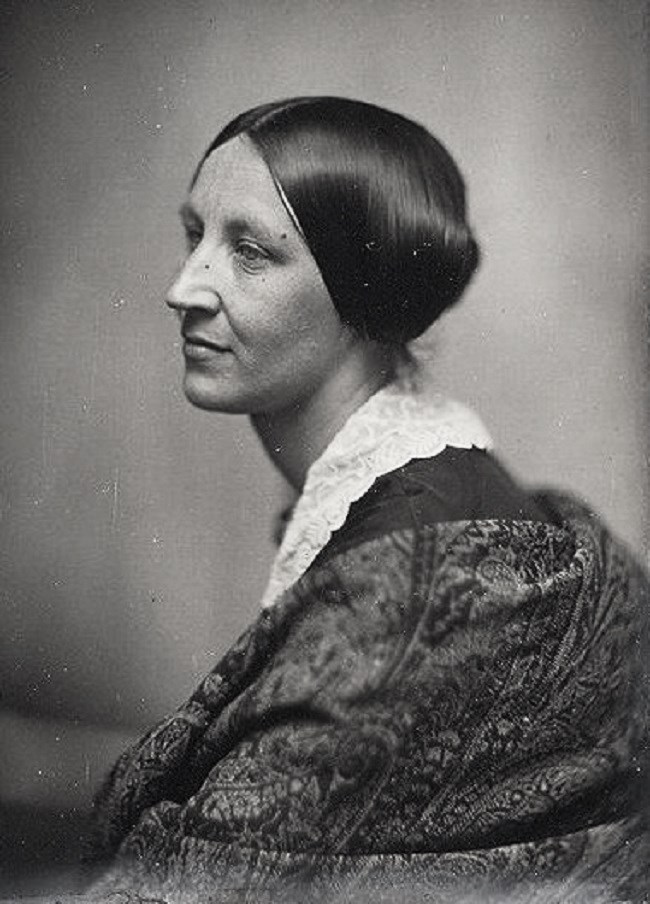Susan B. Anthony (1820-1906) is perhaps the most widely known suffragist of her generation and has become an icon of the woman’s suffrage movement. Anthony traveled the country to give speeches, circulate petitions, and organize local women’s rights organizations.
Anthony was born in Adams, Massachusetts. After the Anthony family moved to Rochester, New York in 1845, they became active in the antislavery movement. Antislavery Quakers met at their farm almost every Sunday, where they were sometimes joined by Frederick Douglass and William Lloyd Garrison. Later two of Anthony's brothers, Daniel and Merritt, were anti-slavery activists in the Kansas territory.
In 1848 Susan B. Anthony was working as a teacher in Canajoharie, New York and became involved with the teacher’s union when she discovered that male teachers had a monthly salary of $10.00, while the female teachers earned $2.50 a month. Her parents and sister Marry attended the 1848 Rochester Woman’s Rights Convention held August 2.
Anthony’s experience with the teacher’s union, temperance and antislavery reforms, and Quaker upbringing, laid fertile ground for a career in women’s rights reform to grow. The career would begin with an introduction to Elizabeth Cady Stanton.
On a street corner in Seneca Falls in 1851, Amelia Bloomer introduced Susan B. Anthony to Elizabeth Cady Stanton, and later Stanton recalled the moment: “There she stood with her good earnest face and genial smile, dressed in gray silk, hat and all the same color, relieved with pale blue ribbons, the perfection of neatness and sobriety. I liked her thoroughly, and why I did not at once invite her home with me to dinner, I do not know.”
Meeting Elizabeth Cady Stanton was probably the beginning of her interest in women’s rights, but it is Lucy Stone’s speech at the 1852 Syracuse Convention that is credited for convincing Anthony to join the women’s rights movement.
In 1853 Anthony campaigned for women's property rights in New York State, speaking at meetings, collecting signatures for petitions, and lobbying the state legislature. Anthony circulated petitions for married women's property rights and woman suffrage. She addressed the National Women’s Rights Convention in 1854 and urged more petition campaigns. In 1854 she wrote to Matilda Joslyn Gage that “I know slavery is the all-absorbing question of the day, still we must push forward this great central question, which underlies all others.”
By 1856 Anthony became an agent for the American Anti-Slavery Society, arranging meetings, making speeches, putting up posters, and distributing leaflets. She encountered hostile mobs, armed threats, and things thrown at her. She was hung in effigy, and in Syracuse her image was dragged through the streets.
At the 1856 National Women’s Rights Convention, Anthony served on the business committee and spoke on the necessity of the dissemination of printed matter on women’s rights. She named The Lily and The Woman’s Advocate, and said they had some documents for sale on the platform.
Stanton and Anthony founded the American Equal Rights Association and in 1868 became editors of its newspaper, The Revolution. The masthead of the newspaper proudly displayed their motto, “Men, their rights, and nothing more; women, their rights, and nothing less.”
By 1869 Stanton, Anthony and others formed the National Woman Suffrage Association and focused their efforts on a federal woman’s suffrage amendment. In an effort to challenge suffrage, Anthony and her three sisters voted in the 1872 Presidential election. She was arrested and put on trial in the Ontario Courthouse, Canandaigua, New York. The judge instructed the jury to find her guilty without any deliberations, and imposed a $100 fine. When Anthony refused to pay a $100 fine and court costs, the judge did not sentence her to prison time, which ended her chance of an appeal. An appeal would have allowed the suffrage movement to take the question of women’s voting rights to the Supreme Court, but it was not to be.
From 1881 to 1885, Anthony joined Elizabeth Cady Stanton and Matilda Joslyn Gage in writing the History of Woman Suffrage.
Susan B Anthonuy and Elizabeth Caty Stanton
As a final tribute to Susan B. Anthony, the Nineteenth Amendment was named the Susan B. Anthony Amendment. It was ratified in 1920.
National Park Service



